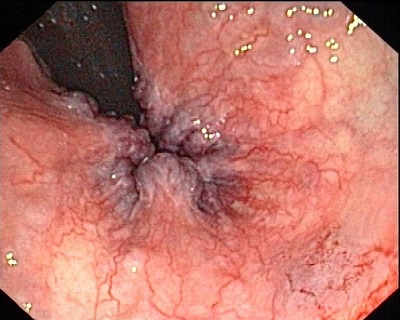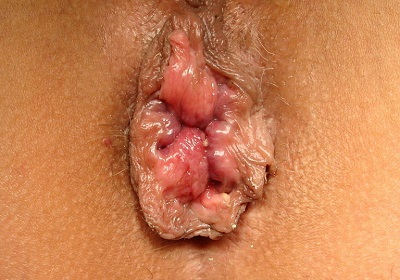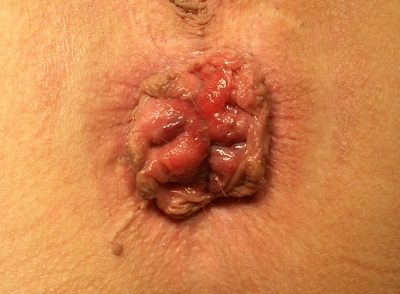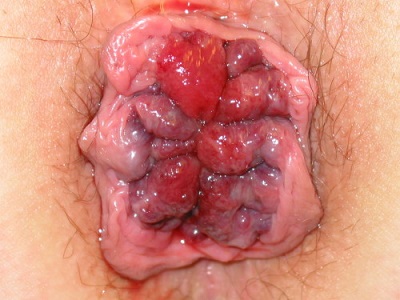Hemorrhoids are vascular structures found in everyone’s anatomy in the anal canal that help with the control of stool. They can become pathological when they swell and can have different symptoms depending on the type of inflammation. Normally, they act as a cushion because they are composed of connective tissue. Pathological hemorrhoids occur in two main types; internal and external hemorrhoids. For internal hemorrhoids there is rectal bleeding but no pain while for external ones, there is significant pain and swelling in the area. They are usually caused by pressure on the veins like during pregnancy or from straining when one is constipated. They are a common occurrence but luckily they do usually respond to medication.
The different types of hemorrhoids include internal hemorrhoids. The symptoms of these hemorrhoids are rectal bleeding during bowel movement or afterwards and bright red skin around the anal area. Other symptoms that may be experienced are a mucous discharge, itchiness, fecal incontinence and a perianal mass incase the hemorrhoids prolapsed through the anus. Internal hemorrhoids can be classified according to the level of prolapsed which leads to the next type.
Prolapse hemorrhoids may be in three grades. The prolapsed tissue can go back on its own after a bowel movement, the prolapse may require the patient to push it back in and the last and most painful level is when the prolapse cannot be pushed back in by the patient. The prolapsing tissue usually results in itching and irritation around the anus because the tissue collects mucus and miniscule fecal particles as it is protruding.
CLICK HERE TO GET RID OF HEMORRHOIDS NATURALLY
External hemorrhoids are usually bluish in color and occur as a painful lump outside the anus. They typically occur after an unusual and prolonged amount of straining. The pain may resolve in two or three days although the swelling may take longer to disappear lasting a few weeks. However, external hemorrhoids may become thrombosed and result in serious problems and a lot of pain.
Thrombosed hemorrhoids are caused by a blood clot that occurs in the skin that is firmly attached to the underlying anal tissues. The pressure in these tissues goes up rapidly and the resulting pain is constant and can be very severe. The skin may break and the clotted blood will begin to leak out because of the elevated pressure. These hemorrhoids cause a lot of discomfort as compared to the intermittent uncomfortable periods experienced in external hemorrhoids.
Bleeding hemorrhoids are extremely painful and may result to further infections. They occur when the irritation and inflammation of the hemorrhoid tissues escalate until they start to rupture. Also as long as they are bleeding healing will take a very long time so you should take care to stop bleeding as soon as possible. It is possible to lessen and soothe the irritation as well as stop the bleeding.
Chronic hemorrhoids can either be internal or external. These are when recurrent symptoms occur and home remedies that usually work have no effect. They may be treated surgically especially if they occur in conjunction with other symptomatic diseases such as fistula, papilla and fissure.
Coagulated hemorrhoids refer to the dead hemorrhoid tissues that are left behind after coagulation therapy. This is a medical procedure that is used to treat small and mid-sized hemorrhoids. A device which creates a beam of infrared light which produces heat that causes scar tissue. This cuts off the blood supply to the vascular tissues and the hemorrhoid dies. A scar usually forms along the wall of the anal canal as a result of the procedure.
Strangulated hemorrhoids are internal hemorrhoids that have developed up to grade 4 and can therefore not be pushed back in manually. These occur when the blood supply to an internal hemorrhoid is cut off or compromised. This results in necrosis or the hemorrhoid dying. The death of a hemorrhoid should usually be a good thing but in this case there is a higher risk of complications and can lead to infection, thrombosis, sepsis or gangrene. Treatment of strangulated hemorrhoids is usually by a surgical procedure called hemorrhoidectomy.
Infected hemorrhoids are strangulated hemorrhoids that have died and resulted in complications. In the case of external hemorrhoids, they are those that have thrombosed to the point where an infection has arisen. An abscess usually forms when a localized infection occurs resulting in the formation and discharge of pus. This could lead to generalized infection or sepsis. Surgery is the most effective treatment for this.
Inflamed hemorrhoids are hemorrhoids that have swollen, become hot and painful as a result of pathogens. The inflammation can be acute or chronic. Acutely inflamed hemorrhoids can be very uncomfortable as the irritation and itching could really drive you up the wall. However, itching will only make the situation worse. Ice the area instead for relief that will not do you more harm. Apply an ice pack to the area for about 15 minutes five times a day.
Treatment of hemorrhoids can effectively be done at home. Adding fiber to your diet will soften stool enough to lessen the pressure exerted on the hemorrhoids. Foods that are high in fiber include beans, broccoli, wheat, fruits and wheat as well as whole grain foods. You should start slowly because increasing the fiber content in your diet drastically could be worse for your condition. You could also try fiber supplements and remember to increase your fluid intake.
Exercise can help stimulate your bowel movements and also help you lose weight which will reduce the amount of pressure being placed on your hemorrhoids. Establishing a regular bowel habit can help prevent hemorrhoids and alleviate symptoms. When you feel like going to the toilet do not delay as this could cause stool to back up and result in piles. An effective home remedy is the use of a sitz. This is a warm water bath specifically for the buttocks and hips. It helps relieve irritation, itching and sphincter muscle spasms. Pat gently afterwards or use a hair dryer. You can also seek topical relief by applying over-the-counter creams to soothe the itching and irritation.
Procedures that require to be done by medical practitioners include rubber band litigation where a rubber band is placed around the hemorrhoid’s base to shrink the size of the hemorrhoid and scar the tissue around it. Another procedure used is hemorrhoidectomy which is a surgical process that cures 95% of hemorrhoid cases. It is however very painful and requires anesthesia. A newer alternative is stapled hemorrhoidoplexy which treats prolapsed hemorrhoids and bleeding.
What Do Hemorrhoids Look Like and the 4 Grades of Internal Hemorrhoids
Hemorrhoids are caused by stagnation or a block in the flow of blood in the anal and rectal areas, causing veins to be inflamed. They are an embarrassing and painful condition to have. It’s important to learn about what hemorrhoids look like and the 4 grades of internal hemorrhoids to have a better grasp of the condition and to know what to do. Depending on the gravity of the condition, a person who suffers from hemorrhoids can either opt to self-medicate using alternate cures or herbal medicines, or to use creams, or have a visit with the doctor.
There are two kinds of hemorrhoids and it is essential to know these two types to better handle the condition, as well as, provide proper treatment for the patient.
EXTERNAL HEMORRHOIDS
External hemorrhoids are more painful than internal hemorrhoids. They usually occur in the anus itself. When a person eliminates waste and he has an external hemorrhoid, the hemorrhoid would usually prolapse and the person can see and feel it. The size of an external hemorrhoid can vary greatly. It ranges from being pea-sized to the extremes of being the size of a golf ball. The common size of a hemorrhoid is that of a grape. Sometimes, external hemorrhoids can occur in groups. Recovery time can vary depending on the size and number of hemorrhoids.
People who experience hemorrhoids may exhibit an unpleasant smell. Because of the irritation and inflammation around the anus, anal leakage can occur and can cause individuals to have a fecal odor. This is due to the bumps irritating the anal sphincter. When hemorrhoids first occur, they are usually soft to the touch. But they harden when a clot starts to form and cause a thrombosis to occur.
Thrombosis is a common condition wherein blood clots form from prolapsed external hemorrhoids. When this happens, the external hemorrhoid would turn blue or purple and would become extremely painful and uncomfortable as they are prone to bleeding and itching.
Hemorrhoids are not serious threats to life and would usually disappear within a few weeks. However, if the pain is persistent, a health care provider or a doctor can perform an operation to remove the hemorrhoid. When an external hemorrhoid shrinks and eventually, disappears, a skin tag would usually form around the area. The skin tag could be removed by a surgeon if the patient wills it. Note that if any anal bleeding occurs, it is important to have an examination with a doctor as this can be an indication of other more threatening conditions like colorectal cancer.
INTERNAL HEMORRHOIDS
Unlike external hemorrhoids, internal hemorrhoids are not usually visible until they undergo a severe case of prolapse. Internal hemorrhoids are less painful than external hemorrhoids and people who have them can sometimes not notice that they have had the condition. They aren’t as painful as external hemorrhoids because they occur in the anal canal where there aren’t as much nerve endings. The discomfort usually arises when the hemorrhoid prolapses and is squeezed by the anal muscles.
An internal hemorrhoid is accompanied by bright red rectal bleeding during or after an individual eliminates waste. This is usually painless but the stool is usually colored and is covered with blood. The pain with internal hemorrhoids usually come when they become thrombosed or necrotic. Internal hemorrhoids can also be accompanied by itchiness, mucous discharge, and a lack of control in bowel movement. If an internal hemorrhoid prolapses through the anus, a perianal mass can form. When this happens, the hemorrhoid can take up to two months or more to heal.
THE FOUR GRADES OF INTERNAL HEMORRHOIDS
Internal hemorrhoids are classified into four categories depending on the severity of the condition. The basis of such categorization is the severity of the prolapse.
GRADE I
 The hemorrhoid has not prolapsed yet. However, prominent blood vessels are occurring. In other words, the hemorrhoid is swollen but is staying inside the anal canal. If grade I hemorrhoids doesn’t worsen, then it is alright to just wait it out. It can also be treated with the avoidance of fatty or spicy foods and the non-taking in of NSAIDs or non-steroidal anti-inflammatory drugs. The addition of fiber to the diet of the patient is also highly recommended.
The hemorrhoid has not prolapsed yet. However, prominent blood vessels are occurring. In other words, the hemorrhoid is swollen but is staying inside the anal canal. If grade I hemorrhoids doesn’t worsen, then it is alright to just wait it out. It can also be treated with the avoidance of fatty or spicy foods and the non-taking in of NSAIDs or non-steroidal anti-inflammatory drugs. The addition of fiber to the diet of the patient is also highly recommended.
GRADE II
 Prolapse happens but it also reduces spontaneously. This means that the bumps can be pushed into the anus by passing stool but the said bumps would also retract on their own. These can be treated with non-surgical procedures but make sure to consult with a certified health care provider before going into any kind of treatment.
Prolapse happens but it also reduces spontaneously. This means that the bumps can be pushed into the anus by passing stool but the said bumps would also retract on their own. These can be treated with non-surgical procedures but make sure to consult with a certified health care provider before going into any kind of treatment.
GRADE III
 Prolapse happens but manual reduction is needed. In this case, the swollen bump has been pushed outside by the stool but must be pushed inside the canal by the person suffering from grade III internal hemorrhoids. Like grade II hemorrhoids, non-surgical treatments are recommended to cure this type of internal hemorrhoid.
Prolapse happens but manual reduction is needed. In this case, the swollen bump has been pushed outside by the stool but must be pushed inside the canal by the person suffering from grade III internal hemorrhoids. Like grade II hemorrhoids, non-surgical treatments are recommended to cure this type of internal hemorrhoid.
GRADE IV
 Prolapse had occurred and it cannot be manually reduced. In the last grade of internal hemorrhoids, the bump of the hemorrhoid once pushed out will stay outside the anal canal and can’t be shoved back. When grade IV or severe grade III hemorrhoids become symptomatic, it is recommended that they be treated with surgical hemorrhoidectomy. Treatment and conditions such as these require prompt consultation with doctors or accredited clinics.
Prolapse had occurred and it cannot be manually reduced. In the last grade of internal hemorrhoids, the bump of the hemorrhoid once pushed out will stay outside the anal canal and can’t be shoved back. When grade IV or severe grade III hemorrhoids become symptomatic, it is recommended that they be treated with surgical hemorrhoidectomy. Treatment and conditions such as these require prompt consultation with doctors or accredited clinics.
Another recommended treatment is PPH or procedure for prolapsing hemorrhoids (also known as stapled hemorrhoid surgery). This is non-invasive and a great alternative to treating severe hemorrhoids. The results, both short-term and medium-term, are well-received. Skin tags excision is also done to restrict discomfort.
While it is important to gain knowledge about what hemorrhoids look like and the 4 grades of internal hemorrhoids, it is also extremely important to consult with a doctor or a health care provider as they can give better diagnosis to a patient’s condition. Hemorrhoids are a common condition and most people will experience it at least once in their lives. However, it is not necessary to suffer from this condition and that’s why it’s important to know how to prevent and to cure hemorrhoids at the very least.


